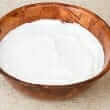Background
- Shea butter comes from the nut of the shea tree, which grows in West Africa. It has been used for centuries in Africa for various skin protecting effects.
- Shea butter has been marketed as a skin and hair moisturizer and as a treatment for a variety of skin conditions including acne, burns, chapped lips, dry skin, eczema, psoriasis, scars, stretch marks, and wrinkles. It has also been used as a cream to relieve arthritis and rheumatism and to heal bruises and muscle soreness, however, there is questionable evidence to support these uses of shea butter.
- Based on human study, shea butter may be effective for relief of nasal congestion, lowering cholesterol levels, and for blood thinning.
References
- Berry, SE, Miller, GJ, and Sanders, TA. The solid fat content of stearic acid-rich fats determines their postprandial effects. Am J Clin Nutr. 2007;85(6):1486-1494.
View Abstract - Di Vincenzo, D, Maranz, S, Serraiocco, A, et al. Regional variation in shea butter lipid and triterpene composition in four African countries. J Agric.Food Chem. 9-21-2005;53(19):7473-7479.
View Abstract - Itoh, T, Tamura, T, and Matsumoto, T. 24-Methylenedammarenol: a new triterpene alcohol from shea butter. Lipids 1975;10(12):808-813.
View Abstract - Loden, M and Andersson, AC. Effect of topically applied lipids on surfactant-irritated skin. Br J Dermatol. 1996;134(2):215-220.
View Abstract - Maranz, S and Wiesman, Z. Influence of climate on the tocopherol content of shea butter. J Agric Food Chem. 5-19-2004;52(10):2934-2937.
View Abstract - Maranz, S, Wiesman, Z, and Garti, N. Phenolic constituents of shea (Vitellaria paradoxa) kernels. J Agric Food Chem. 10-8-2003;51(21):6268-6273.
View Abstract - Mital, HC, Adotey, J, and Dove, FR. The study of shea butter. 3. Comparative assessment of antioxidants and release of medicaments. Pharm Acta Helv. 1974;49(1):28-30.
View Abstract - Sanders, TA and Berry, SE. Influence of stearic acid on postprandial lipemia and hemostatic function. Lipids 2005;40(12):1221-1227.
View Abstract - Tella, A. Preliminary studies on nasal decongestant activity from the seed of the shea butter tree, Butyrospermum parkii. Br J Clin Pharmacol. 1979;7(5):495-497.
View Abstract - Tholstrup, T, Marckmann, P, Jespersen, J, et al. Fat high in stearic acid favorably affects blood lipids and factor VII coagulant activity in comparison with fats high in palmitic acid or high in myristic and lauric acids. Am J Clin Nutr. 1994;59(2):371-377.
View Abstract - Tholstrup, T. Influence of stearic acid on hemostatic risk factors in humans. Lipids 2005;40(12):1229-1235.
View Abstract







